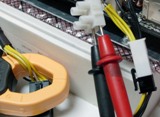Differentiation of installation and commissioning works in accordance with regulatory documents
 In the current regulatory documents, such as Building norms and rules, price tags for the installation of equipment, etc., a sequence is imposed for carrying out separate stages of installation and commissioning, as well as regulating the relations between the parties during the installation and commissioning operation of the equipment.
In the current regulatory documents, such as Building norms and rules, price tags for the installation of equipment, etc., a sequence is imposed for carrying out separate stages of installation and commissioning, as well as regulating the relations between the parties during the installation and commissioning operation of the equipment.
So, for example, in SNiP, the revision and drying of electric motors, as well as their assembly (after revision), are carried out by electrical installation organizations. As a rule, the engine is revised before its installation. Individual testing of the installed equipment without load and under load to establish the quality of the installation is carried out by the organization that installs the equipment.Starting the electric motor during the test operation without load and under load, as provided for in the current price tags for equipment installation, is carried out by the electrical installation organization together with the organization performing the installation of technological equipment.
After completion of individual tests of the installed equipment, carried out by the installation organizations, the equipment is accepted by the work committee for comprehensive testing according to the act. From the moment of signing the said act, the equipment is considered accepted by the customer.
It follows from the above that the installation work ends with an individual test of the installed equipment, which is carried out by the installation organization, and they are included in the scope of the installation and are paid for from the investment.
Commissioning works are carried out by the client or a specialized organization on his behalf. Commissioning and installation works are not included in the scope of the installation and are financed from the funds of the main activities of the client enterprise.
Commissioning works differ from installation works in their specifics: the technology, tools used, equipment, materials and qualification are effective.
Assembly, assembly, welding and rigging operations prevail in assembly work, while in commissioning the main work is: setting and measuring parameters, testing equipment in different modes, developing and implementing organizational and technical measures to achieve its design capacity .
Commissioning requires complex tools and special devices.Commissioning staff (more than 50%) are engineers and technicians.
